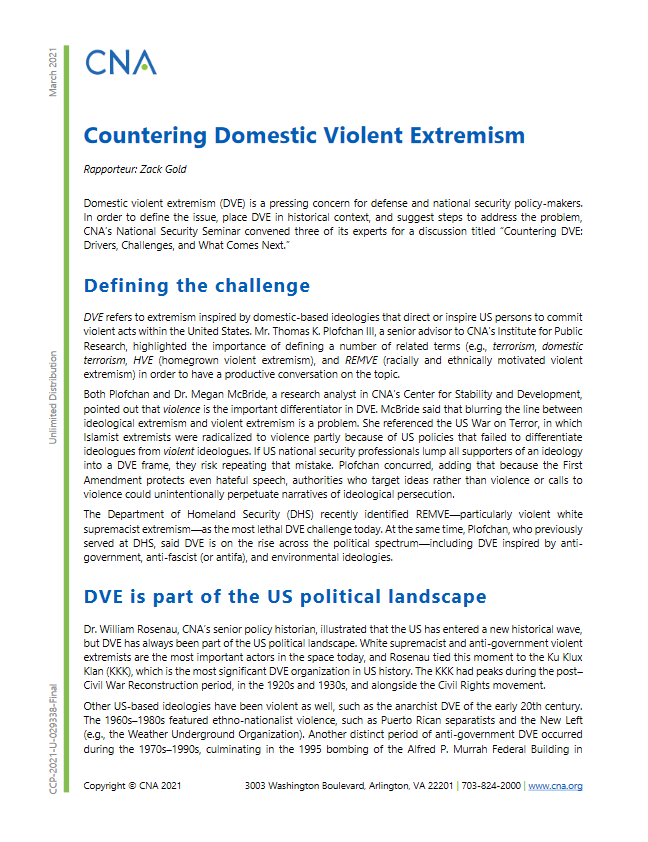Domestic violent extremism (DVE) is a pressing concern for defense and national security policy-makers. In order to define the issue, place DVE in historical context, and suggest steps to address the problem, CNA’s National Security Seminar convened three of its experts for a discussion titled “Countering DVE: Drivers, Challenges, and What Comes Next.”
Defining the challenge
DVE refers to extremism inspired by domestic-based ideologies that direct or inspire US persons to commit violent acts within the United States. Mr. Thomas K. Plofchan III, a senior advisor to CNA’s Institute for Public Research, highlighted the importance of defining a number of related terms (e.g., terrorism, domestic terrorism, HVE (homegrown violent extremism), and REMVE (racially and ethnically motivated violent extremism) in order to have a productive conversation on the topic.
Both Plofchan and Dr. Megan McBride, a research analyst in CNA’s Center for Stability and Development, pointed out that violence is the important differentiator in DVE. McBride said that blurring the line between ideological extremism and violent extremism is a problem. She referenced the US War on Terror, in which Islamist extremists were radicalized to violence partly because of US policies that failed to differentiate ideologues from violent ideologues. If US national security professionals lump all supporters of an ideology into a DVE frame, they risk repeating that mistake. Plofchan concurred, adding that because the First Amendment protects even hateful speech, authorities who target ideas rather than violence or calls to violence could unintentionally perpetuate narratives of ideological persecution.
The Department of Homeland Security (DHS) recently identified REMVE—particularly violent white supremacist extremism—as the most lethal DVE challenge today. At the same time, Plofchan, who previously served at DHS, said DVE is on the rise across the political spectrum—including DVE inspired by antigovernment, anti-fascist (or antifa), and environmental ideologies.
DVE is part of the US political landscape
Dr. William Rosenau, CNA’s senior policy historian, illustrated that the US has entered a new historical wave, but DVE has always been part of the US political landscape. White supremacist and anti-government violent extremists are the most important actors in the space today, and Rosenau tied this moment to the Ku Klux Klan (KKK), which is the most significant DVE organization in US history. The KKK had peaks during the post–Civil War Reconstruction period, in the 1920s and 1930s, and alongside the Civil Rights movement.
Other US-based ideologies have been violent as well, such as the anarchist DVE of the early 20th century. The 1960s–1980s featured ethno-nationalist violence, such as Puerto Rican separatists and the New Left (e.g., the Weather Underground Organization). Another distinct period of anti-government DVE occurred during the 1970s–1990s, culminating in the 1995 bombing of the Alfred P. Murrah Federal Building in Oklahoma City. The historical lesson to consider in the current wave, according to Rosenau, is that DVE can be subdued, not eliminated, and will reemerge periodically
Download reportUnlimited Distribution
Details
- Pages: 2
- Document Number: CCP-2021-U-029338-Final
- Publication Date: 3/10/2021
